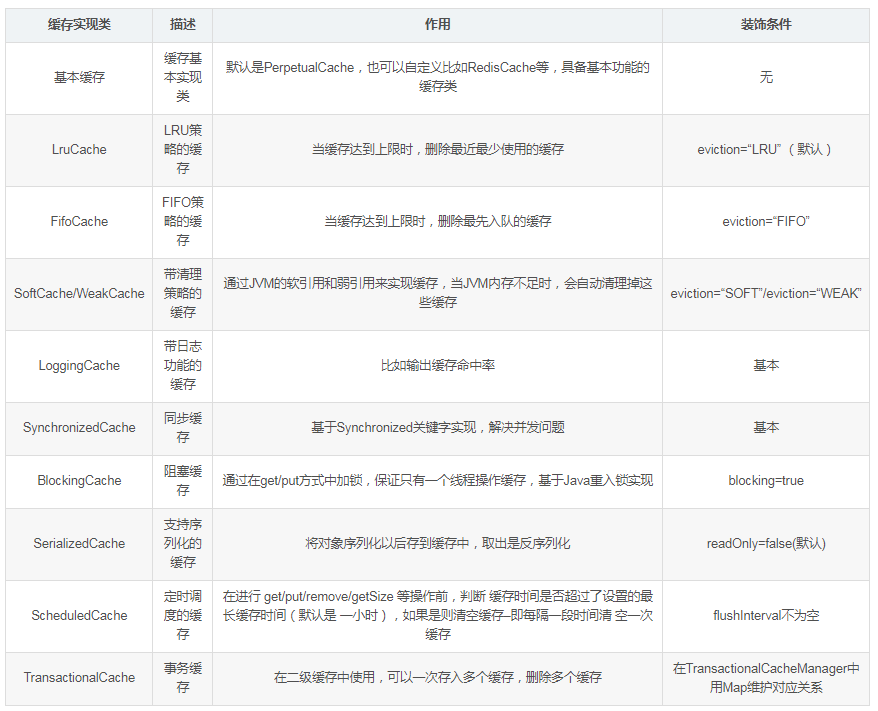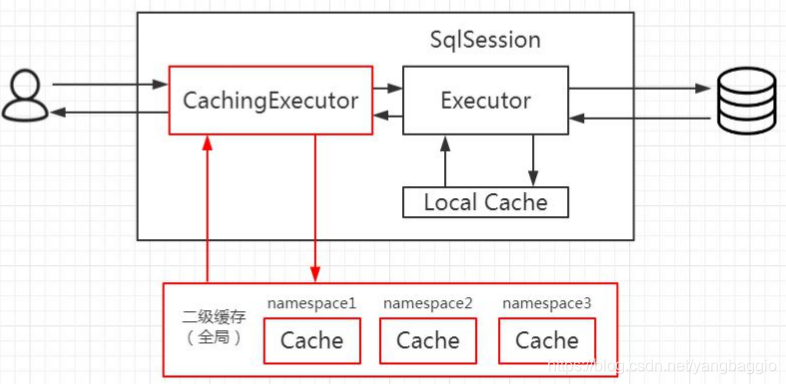目录
一、简介
在缓存中有需要的数据,就不用从数据库中获取转而从缓存中获取,这样就大大提高了系统性能。
PerpetualCache
mybatis顶级缓存接口cache , 有且仅有一个默认实现PerpetualCache,其提供了基础的缓存服务
增强的缓存功能
缓存需要提供更多额外的功能,比如回收策略、日志记录、定时刷新等,这里我们使用了装饰器模式,比如:LruCache 、LoggingCache等
分类
缓存可以大体归为三类:基本类缓存、淘汰算法缓存、装饰器缓存。

二、原理
1、PerpetualCache源码
基础功能类缓存,内部使用HashMap实现。
public class PerpetualCache implements Cache {
private String id;
//缓存的容器
private Map<Object, Object> cache = new HashMap<Object, Object>();
public PerpetualCache(String id) {
this.id = id;
}
public String getId() {
return id;
}
public int getSize() {
return cache.size();
}
public void putObject(Object key, Object value) {
cache.put(key, value);
}
public Object getObject(Object key) {
return cache.get(key);
}
// 移除缓存想
public Object removeObject(Object key) {
return cache.remove(key);
}
//清除缓存
public void clear() {
cache.clear();
}
public ReadWriteLock getReadWriteLock() {
return null;
}
public boolean equals(Object o) {
if (getId() == null) throw new CacheException("Cache instances require an ID.");
if (this == o) return true;
if (!(o instanceof Cache)) return false;
Cache otherCache = (Cache) o;
return getId().equals(otherCache.getId());
}
public int hashCode() {
if (getId() == null) throw new CacheException("Cache instances require an ID.");
return getId().hashCode();
}
}
2、LRUCache ,装饰器增强的缓存
是一种具有 LRU(Least recently used,最近最少使用)算法的缓存实现类。
public class LruCache implements Cache {
private final Cache delegate;
//缓存key的记录 , 用以删除过期的key , 后面使用了LinkedHashMap
private Map<Object, Object> keyMap;
//待删除的key , 删除的时机是新增时 ,如果超过了容量 , 则被动删除
private Object eldestKey;
//看到没,这里传入了一个Cache的实现
public LruCache(Cache delegate) {
this.delegate = delegate;
//设置缓存大小,并重写了LinkedHashMap删除的方法
setSize(1024);
}
@Override
public String getId() {
return delegate.getId();
}
@Override
public int getSize() {
return delegate.getSize();
}
public void setSize(final int size) {
keyMap = new LinkedHashMap<Object, Object>(size, .75F, true) {
private static final long serialVersionUID = 4267176411845948333L;
protected boolean removeEldestEntry(Map.Entry<Object, Object> eldest) {
boolean tooBig = size() > size;
if (tooBig) {
eldestKey = eldest.getKey();
}
return tooBig;
}
};
}
@Override
public void putObject(Object key, Object value) {
//添加数据到PerPetualCache
delegate.putObject(key, value);
//尝试删除过期的数据
cycleKeyList(key);
}
@Override
public Object getObject(Object key) {
keyMap.get(key); //touch
return delegate.getObject(key);
}
@Override
public Object removeObject(Object key) {
return delegate.removeObject(key);
}
@Override
public void clear() {
delegate.clear();
keyMap.clear();
}
public ReadWriteLock getReadWriteLock() {
return null;
}
private void cycleKeyList(Object key) {
//刷新当前key
keyMap.put(key, key);
//如果当存在过期的key时
//从基础缓存里删除
if (eldestKey != null) {
delegate.removeObject(eldestKey);
eldestKey = null;
}
}
}
3、CacheKey
4、一级缓存、二级缓存
一级缓存是sqlSession级别的 、 二级缓存是 mapper级别的。

三、一级缓存
一级缓存也叫本地缓存(LocalCache) , 是SqlSession级别的 , 绑定在BaseExecutor上,看代码:
public abstract class BaseExecutor implements Executor {
//省略了其他代码 ,因为sqlSession 是短暂的 , 所以直接使用基础的缓存对象即可
protected PerpetualCache localCache;
}
访问&创建
BaseExecutor.query()为例
public <E> List<E> query(MappedStatement ms, Object parameter, RowBounds rowBounds, ResultHandler resultHandler, CacheKey key, BoundSql boundSql) throws SQLException {
ErrorContext.instance().resource(ms.getResource()).activity("executing a query").object(ms.getId());
if (closed) throw new ExecutorException("Executor was closed.");
if (queryStack == 0 && ms.isFlushCacheRequired()) {
clearLocalCache();
}
List<E> list;
try {
queryStack++;
// 先查询一级缓存
list = resultHandler == null ? (List<E>) localCache.getObject(key) : null;
if (list != null) {
handleLocallyCachedOutputParameters(ms, key, parameter, boundSql);
} else {
//否则直接查库 并且写一级缓存
list = queryFromDatabase(ms, parameter, rowBounds, resultHandler, key, boundSql);
}
} finally {
queryStack--;
}
if (queryStack == 0) {
for (DeferredLoad deferredLoad : deferredLoads) {
deferredLoad.load();
}
deferredLoads.clear(); // issue #601
if (configuration.getLocalCacheScope() == LocalCacheScope.STATEMENT) {
clearLocalCache(); // issue #482
}
}
return list;
}
删除
清空一级缓存的方式有:
-
update、insert、delete
-
flushCache="true"
-
commit、rollback
-
LocalCacheScope.STATEMENT
public int update(MappedStatement ms, Object parameter) throws SQLException {
ErrorContext.instance().resource(ms.getResource()).activity("executing an update").object(ms.getId());
if (closed) throw new ExecutorException("Executor was closed.");
//先删除缓存
clearLocalCache();
//再更新数据库
return doUpdate(ms, parameter);
}
四、二级缓存
二级缓存是mapper级别的,所以会存在线程共享的问题
public final class MappedStatement {
private String resource;
private Configuration configuration;
private String id;
private Integer fetchSize;
private Integer timeout;
private StatementType statementType;
private ResultSetType resultSetType;
private SqlSource sqlSource;
private Cache cache;
开启
<configuration>
<settings>
<setting name="cacheEnabled" value="true|false" />
</settings>
</configuration>
public Executor newExecutor(Transaction transaction, ExecutorType executorType) {
executorType = executorType == null ? defaultExecutorType : executorType;
executorType = executorType == null ? ExecutorType.SIMPLE : executorType;
Executor executor;
if (ExecutorType.BATCH == executorType) {
executor = new BatchExecutor(this, transaction);
} else if (ExecutorType.REUSE == executorType) {
executor = new ReuseExecutor(this, transaction);
} else {
executor = new SimpleExecutor(this, transaction);
}
//是否开启二级缓存
if (cacheEnabled) {
executor = new CachingExecutor(executor);
}
executor = (Executor) interceptorChain.pluginAll(executor);
return executor;
}
命名空间划分
namespace="com.tian.mybatis.mappers.UserMapper" namespace="com.tian.mybatis.mappers.RoleMapper" 二级缓存是挂在mapper上的,所以不同的命名空间,对应不同的cache空间
访问&更新
CacheingExecutor.query()
public <E> List<E> query(MappedStatement ms, Object parameterObject, RowBounds rowBounds, ResultHandler resultHandler, CacheKey key, BoundSql boundSql)
throws SQLException {
Cache cache = ms.getCache();
if (cache != null) {
flushCacheIfRequired(ms);
if (ms.isUseCache() && resultHandler == null) {
ensureNoOutParams(ms, parameterObject, boundSql);
@SuppressWarnings("unchecked")
//从缓存获取
List<E> list = (List<E>) tcm.getObject(cache, key);
if (list == null) {
//查询数据库
list = delegate.<E> query(ms, parameterObject, rowBounds, resultHandler, key, boundSql);
//回写缓存
tcm.putObject(cache, key, list); // issue #578. Query must be not synchronized to prevent deadlocks
}
return list;
}
}
//没有开启缓存 , 直接查库
return delegate.<E> query(ms, parameterObject, rowBounds, resultHandler, key, boundSql);
}
删除
public int update(MappedStatement ms, Object parameterObject) throws SQLException {
//更新前删除缓存
flushCacheIfRequired(ms);
return delegate.update(ms, parameterObject);
}






















 138
138











 被折叠的 条评论
为什么被折叠?
被折叠的 条评论
为什么被折叠?








